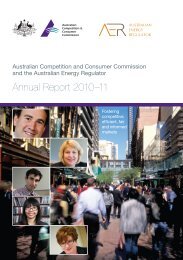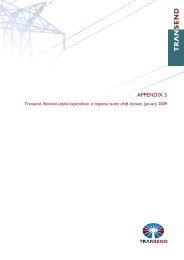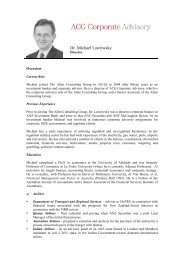Internal consistency of risk free rate and MRP in the CAPM
Internal consistency of risk free rate and MRP in the CAPM
Internal consistency of risk free rate and MRP in the CAPM
You also want an ePaper? Increase the reach of your titles
YUMPU automatically turns print PDFs into web optimized ePapers that Google loves.
conditions. One can test this presumption aga<strong>in</strong>st o<strong>the</strong>r evidence <strong>and</strong>, if<br />
necessary, make an adjustment if that evidence is sufficiently compell<strong>in</strong>g that <strong>the</strong><br />
prevail<strong>in</strong>g cost <strong>of</strong> equity is heightened/depressed relative to its ‘normal’ level. The<br />
evidence <strong>in</strong> this report suggests that if any such adjustment were to be made it<br />
would be positive.<br />
iv. Attempt to estimate a ‘normal’ level <strong>of</strong> <strong>the</strong> equity <strong>risk</strong> premium associated with <strong>the</strong><br />
reference services (i.e. a ‘normal’ level for ( )) <strong>and</strong> add this<br />
to a prevail<strong>in</strong>g estimate <strong>of</strong> <strong>the</strong> <strong>risk</strong> <strong>free</strong> <strong>rate</strong> ( ).<br />
Competition Economists Group<br />
www.CEG-AP.COM<br />
- This is essentially <strong>the</strong> AER methodology. The AER estimates<br />
( ) as <strong>the</strong> product <strong>of</strong> an equity beta estimate (derived<br />
from historical market data) <strong>and</strong> a market <strong>risk</strong> premium figure (also derived<br />
from historical market data). The AER <strong>the</strong>n adds this to <strong>the</strong> prevail<strong>in</strong>g<br />
estimate <strong>of</strong> <strong>the</strong> <strong>risk</strong> <strong>free</strong> <strong>rate</strong>.<br />
151. In my view, each <strong>of</strong> <strong>the</strong> first three methodologies is capable <strong>of</strong> arriv<strong>in</strong>g at an estimate<br />
<strong>of</strong> <strong>the</strong> cost <strong>of</strong> equity for reference services that is consistent with <strong>the</strong> Rules across a<br />
wide range <strong>of</strong> market circumstances. In fact, <strong>the</strong> differences between <strong>the</strong>se<br />
approaches are really ones <strong>of</strong> degree <strong>and</strong>/or emphasis. All <strong>of</strong> <strong>the</strong> first three<br />
methodologies share <strong>the</strong> objective <strong>of</strong> deriv<strong>in</strong>g a forward look<strong>in</strong>g (prevail<strong>in</strong>g) estimate <strong>of</strong><br />
<strong>the</strong> cost <strong>of</strong> equity. Methodologies i) <strong>and</strong> ii) rely solely on prevail<strong>in</strong>g market data to<br />
arrive at an estimate <strong>of</strong> <strong>the</strong> cost <strong>of</strong> equity. Methodology iii) relies on historical average<br />
data <strong>and</strong> <strong>the</strong> presumption, supported by <strong>the</strong> evidence presented <strong>in</strong> this report, that <strong>the</strong><br />
cost <strong>of</strong> equity is relatively stable overtime (more stable than <strong>the</strong> constituent <strong>CAPM</strong><br />
parameters that tend to move <strong>in</strong> <strong>of</strong>fsett<strong>in</strong>g directions).<br />
152. In my view, <strong>the</strong> fourth methodology cannot be relied on to provide a robust estimate <strong>of</strong><br />
<strong>the</strong> prevail<strong>in</strong>g cost <strong>of</strong> equity. This is because it fixes <strong>the</strong> <strong>risk</strong> premium on equity based<br />
on historical evidence but does not similarly fix a consistent estimate <strong>of</strong> <strong>the</strong> <strong>risk</strong> <strong>free</strong><br />
<strong>rate</strong>. Given that <strong>risk</strong> premiums <strong>and</strong> <strong>risk</strong> <strong>free</strong> <strong>rate</strong>s commonly tend to move <strong>in</strong> <strong>the</strong><br />
opposite direction this methodology will tend to underestimate <strong>the</strong> cost <strong>of</strong> equity when<br />
<strong>risk</strong> <strong>free</strong> <strong>rate</strong>s are low <strong>and</strong> overestimate <strong>the</strong> cost <strong>of</strong> equity when <strong>risk</strong> <strong>free</strong> <strong>rate</strong>s are<br />
high.<br />
7.1. Methodology i)<br />
153. The first methodology is entirely forward look<strong>in</strong>g. Assum<strong>in</strong>g that <strong>the</strong> <strong>CAPM</strong> describes<br />
how <strong>in</strong>vestors determ<strong>in</strong>e prevail<strong>in</strong>g conditions <strong>in</strong> <strong>the</strong> market for funds, this<br />
methodology estimates all components <strong>of</strong> <strong>the</strong> <strong>CAPM</strong> formula jo<strong>in</strong>tly. Such an estimate<br />
reflects <strong>the</strong> forward look<strong>in</strong>g assessment <strong>of</strong> both market <strong>risk</strong> (<strong>MRP</strong>) <strong>and</strong> relative <strong>risk</strong> <strong>of</strong><br />
<strong>the</strong> reference services (beta). This approach also implicitly captures <strong>the</strong> actual <strong>risk</strong><br />
<strong>free</strong> <strong>rate</strong> that <strong>in</strong>vestors use when apply<strong>in</strong>g <strong>the</strong> <strong>CAPM</strong> (ra<strong>the</strong>r than need<strong>in</strong>g to adopt a<br />
potentially biased proxy such as CGS).<br />
154. Of course, <strong>the</strong> first methodology does not provide estimates <strong>of</strong> <strong>the</strong> <strong>in</strong>dividual <strong>CAPM</strong><br />
parameters. However, this is a ‘feature’ <strong>and</strong> not a ‘bug’ <strong>of</strong> this approach because<br />
<strong>the</strong>se <strong>in</strong>dividual parameters are <strong>of</strong> little <strong>in</strong>terest if we have already directly estimated<br />
42







